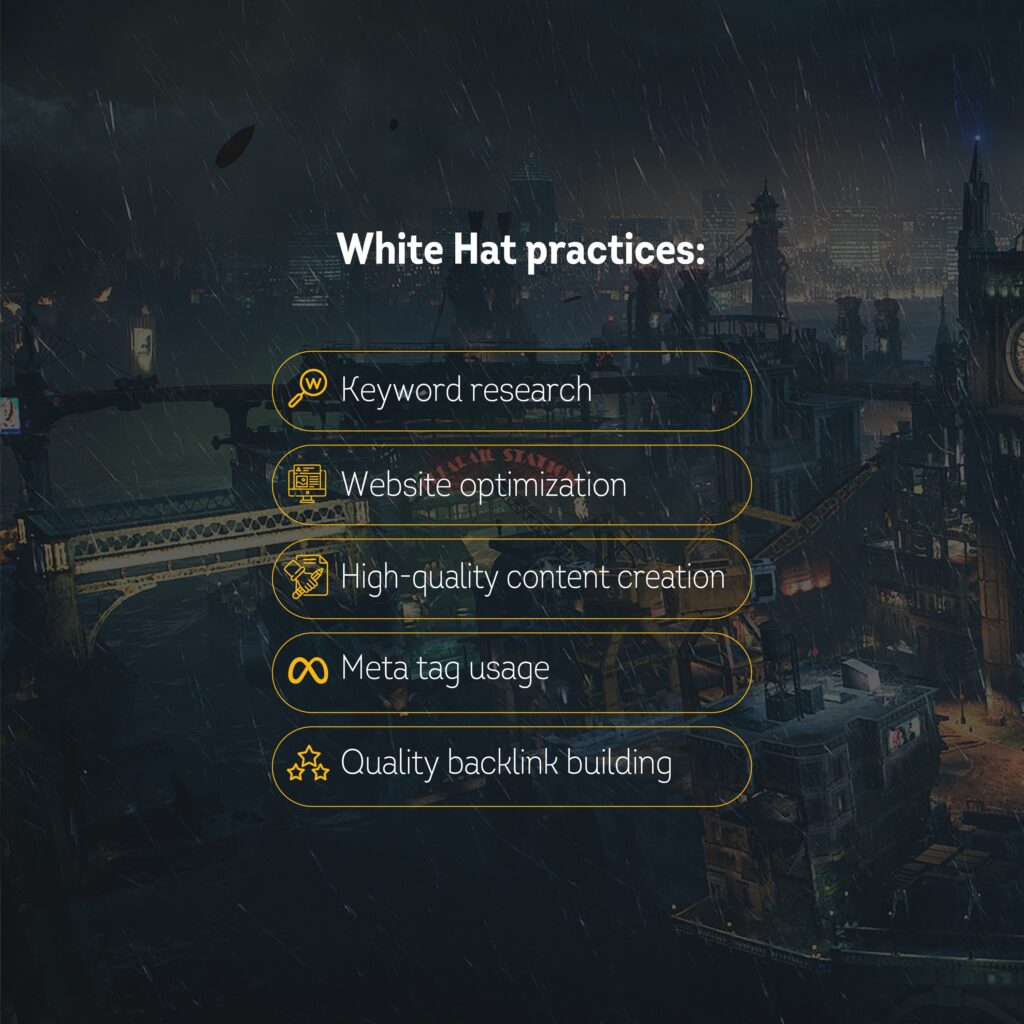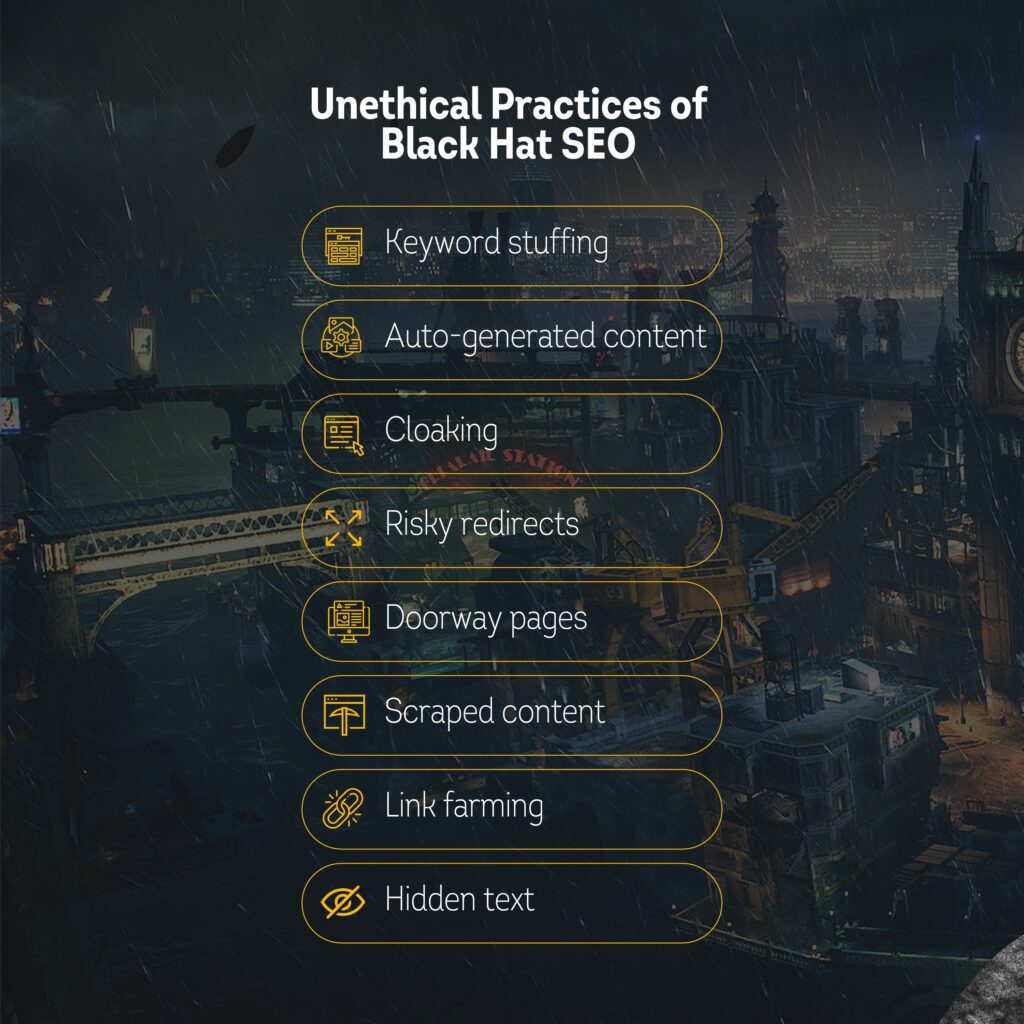In the vast and competitive industry of SEO, the battle for ranking and audience share is intense. The internet is like a huge race; everyone competes to win. People use a lot of practices to increase their rank and visibility. However, not all strategies are the same. SEO strategies can be as Two Faced as the DC villain Two-Face, Harvey Dent. They’re split between “good” and “evil,” representing the ethical and unethical ways of achieving one’s online goals. In this blog, we’ll explore these two sides of the world of SEO (Search Engine Optimization), white hat and black hat practices. We’ll see how they work and why choosing the right one is super important for your website’s success in the search engine race.
What is SEO?
Ever wondered how websites show up when you search for something on Google? Well, that’s where SEO, or Search Engine Optimization, comes into play. Search engine optimization (SEO) is the process that helps websites become more visible and appear higher on Google’s results pages. For website owners, SEO is like a magic wand. It helps them get more visitors without paying for ads through organic traffic and increases their online presence.
Ethical Practices of White Hat SEO
White Hat SEO is like the ‘good guy’ of the SEO world. It’s a set of ethical practices used to make websites more visible on search engines. This is done by creating top-notch content that’s useful for readers. Plus, it’s all about making websites easy to use and accessible for everyone.

But there’s more to it. White Hat SEO also involves smart strategies like building good-quality links and researching keywords. These tricks help bring in real visitors, not just random clicks.
The best part? White Hat SEO doesn’t just help websites; it also makes users happy. And it keeps search engines from punishing websites for doing sneaky or bad stuff. So, it’s like playing by the rules and making the internet a better place for everyone.
White hat practices prioritize the audience. They require more time and effort and a general focus on long-term results.
Examples of White Hat SEO practices
Examples of white hat SEO practices include conducting keyword research, optimizing website structure and navigation, creating high-quality content, using relevant meta tags, and building quality backlinks.
Importance of White Hat SEO for long-term success
White Hat SEO practices are like the secret recipe for long-term success on the internet. They play by the rules set by search engines and make websites better for people like you and me. Websites that use white-hat SEO practices are more likely to achieve:
- Increased visibility: White Hat SEO focuses on optimizing your website for the best possible search engine results. Customers who search for products or services related to your business will be more likely to find you.
- Improved user experience: White Hat SEO follows search engine guidelines. This means that your website is more likely to be built in a way that is easy to navigate and provides a quality user experience. This can lead to more customers engaging with your website, which can lead to increased revenue.
- Long-term success: Following White Hat SEO guidelines helps ensure that your website stays optimized for search engine results over the long term. This means that your website can remain visible to customers for years.
White hat practices help to attract organic traffic by providing users with quality content that is search engine friendly. This content can address their needs and be well-written and optimized for keywords.
Black Hat SEO Practices
What is Black Hat SEO?
Black Hat SEO, like its name suggests, is another way people try to boost their website’s ranking in search engines. But here’s the catch: it does this by breaking the rules set by search engines. It’s like trying to win a race by cheating instead of running fair and square.
People who use Black Hat SEO are usually after quick wins, but it’s a risky game. You see, search engines don’t like cheaters, and they have penalties ready for those who break the rules. Sometimes, the punishment is so severe that the website can get kicked out of search engine results entirely. It’s like getting banned from the race because you cheated too much.
So, while Black Hat SEO might seem tempting for quick results, it’s a risky path that can lead to serious consequences in the long run.
Unethical practices of Black Hat SEO

Black Hat SEO is a set of unethical practices that are used to manipulate search engine rankings. These practices include
- keyword stuffing
- Auto-generated content
- Cloaking
- Risky redirects
- Doorway pages
- Scraped content
- link farming
- hidden text
These tactics are often used to gain an unfair advantage over competitors. They can result in a website being penalized or removed from search engine results. As such, it is important for businesses to avoid these practices and instead focus on creating quality content and using legitimate SEO tactics.
Consequences of Black Hat SEO on website ranking and reputation
Black hat SEO practices can harm website ranking and reputation. Using this face of SEO can put you in trouble with Batman, or should I say “Hatman.”
- Decreased Rankings: Black hat SEO can quickly penalize or delist websites from search engine indexing.
- Reputational Damage: Using black hat SEO techniques can damage a website’s reputation. Search engines may blacklist websites that use these tactics, decreasing website visibility and trustworthiness.
- Legal Issues: Black hat techniques often violate search engine policies, which can result in legal action being taken against the website owner.
A Face Between the Two: Grey Hat SEO Practices
What is Grey Hat SEO?
(image of black, grey, and white palates merging)
Grey Hat SEO is a type of search engine optimization (SEO) that is neither black hat nor white hat. It is a practice that falls somewhere in between the two extremes. It is a practice that uses techniques and strategies that are not strictly within the guidelines but are not considered to be illegal. Examples of such techniques include keyword stuffing, link farming, and doorway pages. Grey Hat SEO is popular among webmasters aiming for fast search engine ranking improvements without the risks of Black Hat SEO.
Risks associated with Grey Hat SEO
Grey hat SEO practices can pose risks to website ranking and reputation. Websites that use greyhat SEO practices may not be penalized immediately. Using unethical techniques is more careful and limited compared to black hat SEO. Yet, it can be detected in the long term, leading to penalization.
Importance of choosing the right SEO practices
When it comes to where a website appears on the internet and how users perceive it, choosing the correct SEO strategies is crucial. If a website employs ethical SEO techniques, it will attract many visitors, just like having a gleaming shop on a popular street.
Websites that follow the laws and employ ethical SEO techniques attract actual visitors like a magnet. They meet people, create a fan base, and establish a solid internet presence. Being a good person in the online community is everything.
But here’s the twist: the rules of this game are always changing. Search engines keep an eye on those who use sneaky SEO tricks (the Black Hat folks) and make new rules to keep things fair. So, it’s important to stay in the loop and check out the latest SEO updates to keep your website in the race for the top spot.
Wear Your Hats Carefully
To sum things up, SEO, which stands for Search Engine Optimization, is like a double-sided coin. It has two faces: one that follows the rules and plays fair and another that bends the rules and tries to cut corners.
The first side, known as ‘White Hat SEO,’ is all about playing by the book. People who use White Hat SEO follow the guidelines set by search engines and work to make websites better for users. It’s like building a house with strong foundations – the website becomes a reliable and trustworthy resource for people looking for information or products.
On the flip side, there’s ‘Black Hat SEO.’ This is where things get a bit shady. Black Hat SEO doesn’t play by the rules. Instead, it tries to trick search engines into ranking a website higher, even if it doesn’t really deserve it. It’s like pretending to be a superhero when you’re not – it might work for a while, but eventually, you’ll get caught.
And then, there’s the middle ground – ‘Grey Hat SEO.’ Grey Hat SEO practitioners don’t completely break the rules, but they don’t always follow them to the letter either. They take some risks that could help a website rank better, but these risks can sometimes harm the website’s reputation.
Choosing the right SEO approach is super important. It’s like deciding how to play a game. If you play by the rules and use White Hat SEO, you’re more likely to attract real visitors, build a loyal fan base, and have a good reputation online. But if you go the Black Hat route, you might see quick results, but it’s a risky game that can lead to penalties and a bad online reputation.
So, remember, in the world of SEO, the choices you make can have a big impact on your website’s ranking and reputation. Choose wisely


